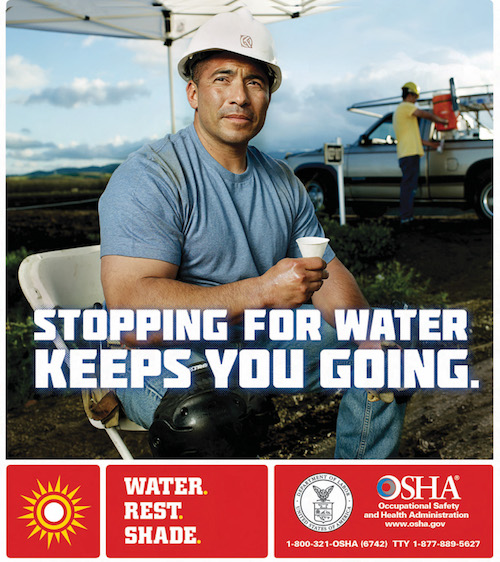It’s that time of year again. The days get longer. The sun rides higher in the sky. And heat-related illnesses start claiming lives and sending working people to hospitals at alarming rates.

|
| OSHA's "Water. Rest. Shade." campaign seeks to protect workers from heat-related illnesses.
|
“Summer is full of vacations and backyard barbecues and quality time spent with our families, but it’s also a dangerous time for our members who work outdoors or in hot conditions,” said International President Lonnie R. Stephenson. “That’s why every year we take a moment to remind folks how to stay safe and take care of themselves and their IBEW brothers and sisters in the heat.”
The Occupational Safety and Health Administration has a simple prescription for avoiding heat-related illnesses: Water. Rest. Shade.
2018 marks the seventh year of the campaign, which seeks to raise awareness among working people of their rights at work and the simple steps they can take to ensure they’re not a part of next year’s heat statistics.
By law, employers are responsible for protecting workers from extreme heat conditions, and OSHA encourages companies to have established heat illness prevention programs.
This can include making sure workers have access to water, rest and shade, allowing new or returning workers to gradually acclimatize to work in extreme conditions, planning for emergencies and training workers on prevention, and monitoring workers for signs of heat-related illnesses.
Heat-related illnesses can include heat stroke, heat exhaustion, heat cramps, fainting, heat rash and severe dehydration. And all of them are preventable.
“Part of the reason dozens of people die and thousands more end up sick or in the hospital every summer is that workers are often unable to realize they’re suffering through a heat-related illness until it’s too late,” said IBEW Director of Safety and Health David Mullen. “Making sure you and your co-workers are taking the right steps to prevent these illnesses and keeping a close eye out for early-warning signs is extremely important, especially this time of year.”
When working in hot conditions, OSHA recommends frequent water and shade breaks as well as the use of cooling fans, air-conditioned equipment cabs and break rooms or trailers, and the use of reflective shields to redirect radiant heat, among other more task-specific measures.
The use of hats and UV-rated sun protective clothing can be helpful when working in direct sun.
Conditions can be made even worse when high temperatures are accompanied by increased humidity, direct sunlight, a lack of air movement or when workers are required to wear protective clothing. In those conditions, OSHA encourages workers and employers to take additional, more aggressive preventative actions.
“It’s important to remember that heat-related illnesses don’t have to happen,” Mullen said. “A little awareness to protect ourselves and those around us goes a long way to keeping everyone safe on the job.”
More information about OSHA’s “Water. Rest. Shade.” campaign can be found on its website, www.osha.gov/heat.